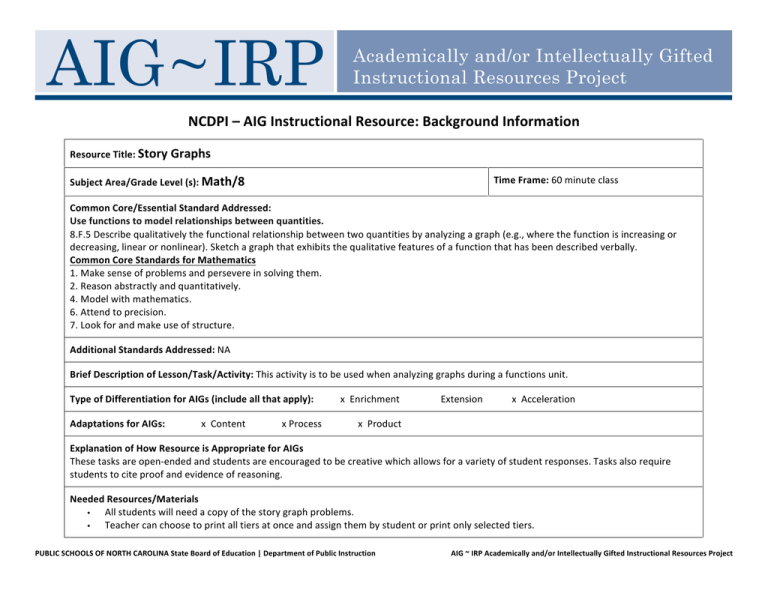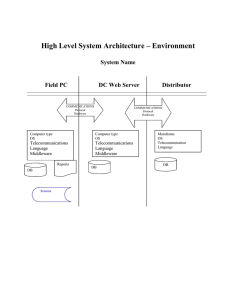NCDPI – AIG Instructional Resource - NCAIGIRP
advertisement

NCDPI – AIG Instructional Resource: Background Information Resource Title: Story Graphs Subject Area/Grade Level (s): Math/8 Time Frame: 60 minute class Common Core/Essential Standard Addressed: Use functions to model relationships between quantities. 8.F.5 Describe qualitatively the functional relationship between two quantities by analyzing a graph (e.g., where the function is increasing or decreasing, linear or nonlinear). Sketch a graph that exhibits the qualitative features of a function that has been described verbally. Common Core Standards for Mathematics 1. Make sense of problems and persevere in solving them. 2. Reason abstractly and quantitatively. 4. Model with mathematics. 6. Attend to precision. 7. Look for and make use of structure. Additional Standards Addressed: NA Brief Description of Lesson/Task/Activity: This activity is to be used when analyzing graphs during a functions unit. Type of Differentiation for AIGs (include all that apply): x Enrichment Extension x Acceleration Adaptations for AIGs: x Content x Process x Product Explanation of How Resource is Appropriate for AIGs These tasks are open-­‐ended and students are encouraged to be creative which allows for a variety of student responses. Tasks also require students to cite proof and evidence of reasoning. Needed Resources/Materials • All students will need a copy of the story graph problems. • Teacher can choose to print all tiers at once and assign them by student or print only selected tiers. PUBLIC SCHOOLS OF NORTH CAROLINA State Board of Education | Department of Public Instruction AIG ~ IRP Academically and/or Intellectually Gifted Instructional Resources Project Sources (all sources must be cited): NA TEACHER NOTES: This activity is tiered. The tier should be assigned according to individual student readiness. Tier I is for lower readiness, Tier II is for middle readiness, and Tier III is for higher readiness. Some students may benefit from completing tasks in multiple tiers. For example, a student who is progressing well but who has not yet mastered the material may benefit from completing 1-­‐2 problems in both Tier II and in Tier III. NCDPI AIG Curriculum Resource Outline STAGE ONE: ENGAGE The following problems could be used to introduce the idea of story graphs as well as help determine student readiness. Observe student questions and work. #1 – The following graph shows the speed of Allison’s car versus time during her ride to school in the morning. Write a brief story describing her ride. Allison’s Car Ride to School Car speed Time Follow-­‐up question: How would your ride to school differ from Allison’s? #2 – Mary jumps on a trampoline. Sketch a graph that shows her height from the trampoline over time. Allow students to share their graphs and likely embellished stories. There will likely be several different student responses depending on if students choose to add details to the story. Follow up: Create a different title and story if the axes were instead labeled distance from the ground and time? PUBLIC SCHOOLS OF NORTH CAROLINA State Board of Education | Department of Public Instruction AIG ~ IRP Academically and/or Intellectually Gifted Instructional Resources Project STAGE TWO: ELABORATE Teachers may use informal/formal assessment to determine which tier (or combination of tiers) a student is assigned to complete. Teachers may also include student input as to readiness for task. • Tier I (low readiness) requires students to analyze a given story or graph and create the matching graph or story. • Tier II (middle readiness) has students make personal connections between story graphs and their daily routines/activities. Students must choose a topic, create a story on that topic, and create a graph with appropriate variables that matches the created story. • Tier III (higher readiness) has students further analyze a situation and multiple graphs for a given situation. This requires students to be able to interpret the same story in terms of more than one pair of variables. This is for students who have mastered the concepts of analyzing graphs with a single variable pair and need more of a challenge. Students can work on problems individually or in pairs/groups with like tier assignments. Guiding questions that can be asked if students need guidance: • What are the variables in the story? In the graph? • How do the variables change during the story? How is this change represented in a graph? • What does a flat section in a graph indicate? What does a sharp increase indicate? (depends on variables) • How is a steady pace represented in a graph? (depends on variables) STAGE THREE: EVALUATE Assessment of this assignment will depend on the tier the student was assigned. For all levels, students need to show graph relationships that match a verbal story. Tier I – Creating stories or graphs #1 – Graph should show that there is a pattern between increases in distance and flat sections (bus stops). #2 – Look for understanding that the first section shows a large distance covered in a short period of time, which indicates that Jacob is sprinting. He then takes a break. After the break he runs at a constant pace. He sprints again at the end. Tier II – Creating stories and graphs • Responses will vary depending on student choice. Successful responses will show a corresponding graph and graph sketch. Tier III – Multiple interpretations of the same graph #1 a – The first graph shows the distance from home over time. The second graph shows the total distance walked over time. Both graphs show a type of distance; it is important to differentiate between distance from a point and total distance. #1b – Students could create a graph that shows speed over time or distance from the store over time. There are several possible responses PUBLIC SCHOOLS OF NORTH CAROLINA State Board of Education | Department of Public Instruction AIG ~ IRP Academically and/or Intellectually Gifted Instructional Resources Project especially if students decide to embellish a bit in the story. #2 – Possible graphs include distance from home over time, distance from school over time, speed traveled over time. Students could also include elaborations to the story to include Sean’s mood or other factor. TEACHER NOTES: Teacher may adjust the tier level the students work on during the class based on observations. PUBLIC SCHOOLS OF NORTH CAROLINA State Board of Education | Department of Public Instruction AIG ~ IRP Academically and/or Intellectually Gifted Instructional Resources Project



